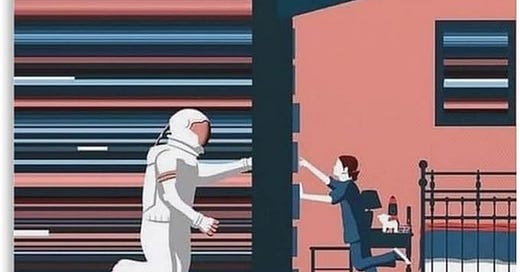Interstellar dir by Christopher Nolan
Christopher Nolan’s Interstellar is long, so be prepared for an odyssey, because it is literally that. But it is not only an odyssey in a physical or intellectual sense, but also a spiritual one. The word that surfaces when I reflect on the film is sacrifice: what we as a human species sacrifice for love and the mucky landscape we enter into when we sacrifice love, “the one thing we are capable of perceiving that transcends dimensions of time and space” according to Anne Hathaway’s character Amelia Brand, for phenomena that is beneath it. A main question the film asks and poses a response to is how does humanity reconcile conflicting, acute pulses of spirit? In the case of the film, love and its replacement walk an alarmingly fine line, which is what makes this theme of sacrifice so apparent. We watch as characters choose between their loved ones and the future of the human race under extreme conditions.
In his review of the film for The New York Times, A.O. Scott writes:
“Trying to jot down notes by the light of the Imax screen, where lustrous images (shot by Hoyte van Hoytema and projected from real 70-millimeter film) flickered, I lost count of how many times the phrase “I’m sorry” was uttered — by parents to children, children to parents, sisters to brothers, scientists to astronauts and astronauts to one another. The whole movie can be seen as a plea for forgiveness on behalf of our foolish, dreamy species. We messed everything up, and we feel really bad about it. Can you please give us another chance?”
The film falls into the science fiction genre and is set in the near future. Humanity is facing the threatening prospect of extinction due to ecocide, or the human destruction of nature. In other words, the dire environmental plight is not chaos-driven, but human-driven. Because of this the scientists and astronauts conducting the Endurance mission are especially torn about their loyalties to their families or to humanity as they feel a responsibility for the predicament that humanity faces. In the excerpt above, Scott’s prose calls attention to the way that the apologies throughout the film disperse and form a web that becomes one great apology cast over the substance of the entire work. It is this web-like apology that centralizes the theme of sacrifice while also refracting it to showcase its many facets, not unlike the tesseract that Cooper (Matthew McConaughey) finds himself in at the end.
Quite impressively, according to an interview with theoretical physicist Kip Thorne, an expert on black holes and wormholes, the film relies on real science for many of its stunning visuals. Thorne provided the math that the special effects artists turned into movie visuals. He even explained in the interview that him and his team learned something new from the digital artists’ simulations:
“We learned [that] when you have a fast-spinning black hole, without any accretion disk, and let it just lens the distant sky—a star field—we saw a fantastically beautiful structure that is sort of like a fingerprint, but much more complex. We've long known that you'll get multiple images of each star [around a black hole], due to [the combination of] light rays that come pretty much directly to the camera, [and] rays that go in and circle around the black hole once and come to the camera. But what we found was that on the side of the spinning black hole where space is moving towards us, [you see this beautiful structure].”
The film won Best Visual Effects at the 87th Academy Awards in 2015. Arguably just as remarkable as the visuals is the score; it was nominated for multiple sound awards.
For an audience of amateurs, the physics driving the film could have been better explained as the movie advances. For instance, the audience would have benefited from a scene inserted at the beginning of the film, maybe in a classroom or boardroom at the secret NASA facility, that reviews certain necessary physics principles pivotal to the film, like Einstein’s general theory of relativity, a brief overview of the five dimensions, a better description of a wormhole, etc. There are “chalkboard moments” when a scientist or an astronaut sketches out a visual model of an anticipated spacecraft route, but the terms used in these sketches are not addressed comprehensively, and they ought to be.
Roughly a decade since its release date, Interstellar is a modern classic that is worth seeing or returning to. The final scene when Cooper is in the tesseract outside of his daughter, Murph’s, bedroom is particularly exceptional with respect to its visual prowess and narrative threading. Certain key details from the inception of the film, like a watch that Cooper gives to his daughter before leaving for the mission, are revisited towards the end, in a way that holds together the experimental epic spaciousness of the film; many healthy mysteries persist around the filmic world’s design, and they are supported by the Nolan brother’s plotline.


